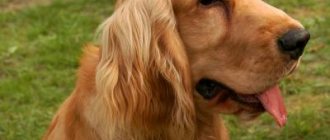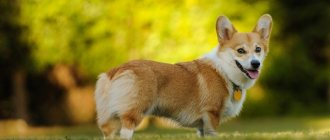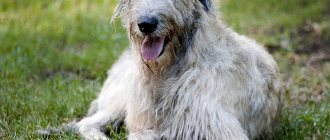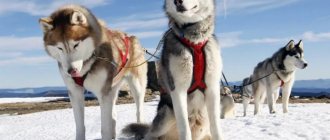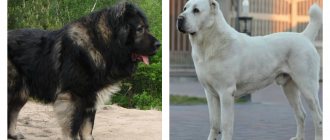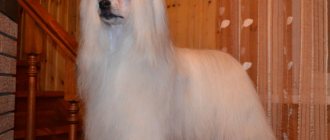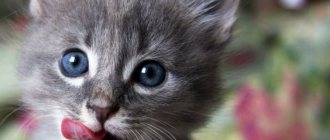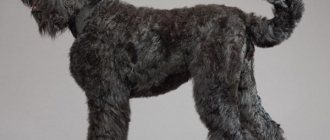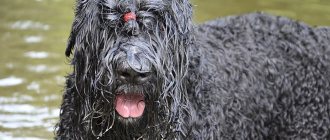History of the breed
As the name suggests, the birthplace of the Russian Terrier is Russia. Before the revolutionary upheaval, English toy terriers were very popular among Russians. But with the advent of Soviet power, they began to be considered bourgeois dogs. Breeding work was practically stopped, the number of English toys decreased sharply. In the mid-fifties of the 20th century, Russian cynologists began working on the creation of Russian toy terriers.
Soon, decorative dogs originally from Moscow gained even more popularity than their English relatives. At first, only smooth-haired toy terriers existed. But in the late fifties, the first representative of the long-haired variety was born. The parents of the unusual puppy with feathering on his ears and legs were a pair of smooth-haired Russian Toys, one of which had a slightly longer coat.
It was decided to breed a long-haired type of Russian Toy. Its founder was the same puppy with fluffy ears. He was crossed with a female dog that had long hair, and the result was the first litter of long-haired Russian Toys.
Despite its miniature size, the decorative dog behaves boldly, even impudently, in any situation. This dog is able to defend its place in the canine team and, if necessary, fearlessly rushes to the defense of its owner.
How to choose a purebred puppy?
Many potential toy owners, who are not interested in the exhibition career of their future pets and who are buying a dog only as a friend and companion, believe that they also do not need documents for a puppy.
They purchase a puppy without documents, at the market or through a newspaper advertisement, and, as a result, they do not get what they wanted at all: the purchased dog turns out to be only vaguely similar to a toy terrier in appearance and does not have the temperament and character traits inherent in this breed.
NOTE!
In order to be sure that the purchased puppy will turn out to be a toy and not, for example, a crossbreed with a miniature pinscher or just a similar mongrel, you need to purchase a dog from a kennel with a good reputation or from a reliable breeder.
The cost of pet-class puppies, not intended for exhibitions and breeding, is usually either equal to or very slightly higher than the price of a baby without documents.
But at the same time, such a puppy relies on a metric that confirms its purebredness.
In order to buy a puppy that best meets the strict requirements of the standard, you often have to wait several months: after all, many promising babies remain in the nurseries where they were born, since few breeders are willing to sell a puppy that will almost certainly grow up to become a winner of the most prestigious exhibitions .
But some of the breeders offer such especially promising babies for co-ownership, the conditions of which are negotiated individually in each case.
In any case, when planning to go for a toy terrier puppy, the owner needs to thoroughly study the breed standard and even write down from it those characteristics of the breed that can be observed even in the smallest puppies.
These are the ones you need to focus on when choosing a show pet.
Breed standard Russian Toy
"Toy" translated from English means "toy". Indeed, dogs of this breed resemble miniature toys. They are on the list of the smallest dogs in the world. The weight of adult individuals does not exceed 3 kg , height is about 20-28 cm .
Elegant, agile, miniature, with thin bones and relatively long legs - this is the Russian Toy. There are two varieties of the breed: long-haired and smooth-haired. They differ from each other in their coat characteristics. Otherwise, the description of the representatives of the Russian Toys is the same.
A wedge-shaped head with a wide skull rests on a beautifully curved neck. Triangular ears with pointed or rounded tips. They are placed high, standing. The muzzle narrows towards the nose. The nose may be brown or black. The eyes are slightly bulging, round, the look is intelligent, expressive. The teeth are sharp and have a scissor bite. The physique is graceful, the back is straight, the stomach is tucked. Limbs are straight, long, parallel. Tail docking up to the second vertebra is allowed.
The coat depends on the type of breed:
Smooth-haired Russian Toy
The coat is short, shiny, and lies close to the body. There is no undercoat. Bald patches are not acceptable.
Longhaired Russian Toy
The coat is 3-5 cm long, straight, lying close to the body. Light waviness is allowed, which does not hide the outline of the body. Ears with beautiful feathering are the main decoration of the long-haired Toy. The fur on the ears is long and thick, like a fringe. Feathers on legs. The paws are covered with elongated hair, under which the claws are not visible.
The color of the coat is distinguished by rich shades. According to the standard, the following colors are allowed: fawn, black and tan, blue and tan, red, brown and tan, lilac and tan.
Nuances of proper care:
- eyes and ears - to prevent diseases, wipe them with a damp swab weekly;
- paws - wipe the limbs with a damp cloth every time after a walk, claws should be cut off regularly;
- fight against parasites - treat your pet’s fur once every few months with appropriate products (Frontline, Advantix). Once every six months it is necessary to prevent worms using tablets or drops;
- things – the breed is whimsical in terms of accessories. Terriers love comfort and need their own playpen, toys and bones. And in winter, your pet should have a real wardrobe for going out for walks.
Keeping and caring for a toy terrier
Such a small, fragile dog cannot live on the street. She needs a warm room, comfort, proper living conditions. The Russian Toy seems to be created for living in an apartment, even the smallest one. A miniature pet, if raised properly, will not cause any problems for household members and will not take up much space.
Even before purchasing a puppy, you need to acquire things that a “pocket” dog cannot do without. The list of such purchases includes: bowls for food and water, clothes for different occasions (walks in summer, winter, going out, traveling...), playpen, carrying bag, house or bed, litter tray or diapers (disposable, reusable), chewing bones, toys, hygiene products, harness.
Of course, it is impossible to list everything that is needed during the care, maintenance and training of a pet, but the main things listed above must be purchased immediately.
It is worth considering the main points regarding the care and education of the Russian Toy:
1. Walk. The toy terrier does not need much physical activity. He may well use up energy running from room to room or playing with toys. The mini-pet quickly gets used to the litter tray or diaper, so there is no need to walk it in the early morning and evening.
The little toy is thermophilic; in cold weather it quickly freezes and can catch a cold. This does not mean that it needs to be kept indoors all the time. It is necessary to walk a Russian Toy Terrier; the dog should walk in the fresh air for 40-60 minutes a day, this is good for his health, both physical and psychological. It is better to determine the walking time during the day (not in the morning or evening) so that it does not freeze.
In warm weather it is not necessary to wear it, except for beauty. In the cold season, it is recommended to keep walks short and do not let the dog go outside without warm clothes. It is not recommended to let a nimble pet off a leash, unless you have the opportunity to walk in sparsely populated places, where there is no transport or stray animals, or when walking in a fenced area.
2. Care of the coat. For a smooth-haired toy, it is enough to brush it once every 5-7 days. Long-haired pets should be combed daily. During the molting period, it is recommended to use a furminator. Russian Toys do not shed profusely, and there will not be any particular difficulties in caring for their coat.
You might find our article useful:
Caring for dog fur at home. Selecting tools
3. Swimming. Representatives of the breed do not have a specific unpleasant odor, but they need to be bathed relatively often - once every 30-40 days. During water procedures, make sure that no water gets into your ears. They must first be plugged with cotton wool.
4. Claws. It needs to be trimmed once every two months; if you don’t do this, the dog will have difficulty walking. Toy terriers do not wear them down naturally on the road surface.
5. Eyes and ears. Regular examination is required to check for signs of infection, as indicated by inflammation and excessive accumulation of discharge. It is forbidden to penetrate the inside of the ears; once every 20-30 days you need to clean only the visible part. Wipe the corners of the eyes where discharge accumulates with a cotton swab dipped in warm water. It is believed that the eyes and ears are the weak points of the Russian Toy Terrier, so they need to be looked after with special attention.
Be sure to read our article:
Daily care for your dog's eyes. How not to miss a disease
6. Anal glands. Due to the overflow of the anal glands, she feels terrible discomfort, and an unpleasant odor appears, which creates discomfort for all household members. To clean the glands, you need to lightly press with your fingers (thumb and index) from the bottom and sides of the anus.
7. Nutrition. It is recommended to feed Russian Toy Terriers premium dry food. It contains everything you need for the normal development and functioning of your pet. A natural method of feeding is also not excluded. The diet should contain 20-30% lean meat. Owners of such dogs should be aware that they have an underdeveloped sense of satiety, so it is strictly forbidden to overfeed their pet. The dog will eat as long as food is available. Such gluttony can result in obesity, bloating or even volvulus.
Proper nutrition
In order for the puppy you bought to grow strong and have ideal health, it should be properly fed. A permanent place must be allocated for feeding. Puppies aged 1.5-3 months are fed five times a day, from three months to six months the animal should eat three times a day, and from 6 months the number of feedings should be 2 times (morning and evening).
Dogs are not herbivores, so their menu must include meat. The baby toy's diet should be properly balanced, providing all the food that is so important for the proper development of the animal. The dog should receive:
• Required amount of animal fats. • Essential plant substances. • Vitamins in sufficient quantities. • Minerals and hydrocarbonates.
Nowadays, an owner who is not yet aware of the correct selection of food for his pet will be able to purchase ready-made balanced food in the store.
Character of the Toy Terrier
The value of the breed is not only in its miniature size and sociability. The Russian Toy can be an ideal pet for a person who has never dealt with dogs before. This is an animal with a sociable temperament.
Devotion, energy, mobility, unobtrusiveness - this is the basis of the Toy’s character. Aggression is not typical of these dogs, although in some cases they show serious viciousness, especially those individuals who have not received proper upbringing. A Russian Toy, ill-mannered and spoiled by its owners, can turn into an uncontrollable, vicious animal. Such a pet, despite its miniature size, will lead all family members, trying to take the place of leader.
Toy terriers get along well with all household members and all pets. They treat strangers with suspicion, but once they get to know each other better, they are ready to play and communicate. They play with children with pleasure, but can stand up for themselves if the baby causes pain. You should not leave a dog alone with a child; both the animal and the children may suffer.
The Russian Toy does not perceive himself as a small dog. Therefore, he does not retreat in front of large dogs. A decorative dog can easily attack a guard dog, putting himself in mortal danger. Males are especially prone to dog fights.
Character and appearance
A small dog with a big head, intelligent eyes, a lean, dry body - this is how you can describe the Russian Toy. The main external signs of a toy terrier:
- same length and height;
- thin legs;
- slender neck;
- straight or falling line of the withers;
- square head and wide forehead;
- scissor bite, with the lower teeth covered by the upper teeth;
- large, erect ears;
- docked tail.
Terriers of the Russian breed are endowed with a lively character. These dogs are able to be friends with other animals. The kids are devoted to their owners and will rush to his defense without hesitation, not thinking about their size. Toy terriers are emotional, love attention and affection, but do not beg for it. The energy of the Toyam was passed down from their ancestors.
Dogs love games and active pastime. But they are wary of strangers.
Training and education
Starting from the age of one month, it is necessary to begin training the dog. The Russian Toy is easy to learn and train. But there are some difficulties and features of education:
- You can’t pamper and praise too much, otherwise she will imagine herself to be the master of the house.
- It is necessary to suppress emerging aggression, prohibit growling without reason.
- Do not allow jumping on strangers.
- Prohibit barking for no reason.
Be sure to read our article on what to do if your dog doesn’t listen
The Russian Toy is a decorative dog, not a service dog. Therefore, the owner himself will handle his training. You can use the advice of a dog trainer to make the training process more successful.
Selection rules
By purchasing an animal, a person takes on a friend for many years. Therefore, it is important to know what kind of toy terrier puppies should be. What you need to pay attention to:
- baby's behavior;
- parents;
- conditions of keeping the bitch and her litter;
- to the breeder.
A toy terrier puppy should give the impression of being a nimble animal and not differ from the rest of the litter. The coat is smooth, shiny, without defects, clean eyes and teeth.
It’s good if you have the opportunity to observe the parents of the toy terrier puppy. Most likely, he will turn out to be similar to them. If a dog's mother or father is aggressive, the offspring may become the same.
It is important to see in what conditions animals grow, mature, and their nutrition. You need to decide in advance who to choose, a girl or a boy. Determine the age of the toy terrier.
A good breeder will easily answer questions about the development of the puppy after birth, give advice, addresses of good veterinary clinics, and recommend food for the pet.
Expert opinion
Anna Abramenko
An avid dog lover. Experience in veterinary medicine since 2009.
Ask a Question
An animal is not a toy that can be changed. In order not to get confused and not be led by chance, it is better to create a table of signs that will help when buying a dog.
Interesting facts about the Toy Terrier breed
- Representatives of the Russian Toy breed are freely allowed to stay in hotels and on public transport.
- The Russian Toy is an excellent hunter of small burrowing animals. It is not for nothing that the name of the breed is loosely translated as “Russian toy burrow dog.”
- The Toy Terrier is the favorite pet of many celebrities and public people.
- Russian Toy females are low-fertile (1-5 puppies per litter).
- Among Russian Toys, long-livers are known with a maximum life expectancy of about 22 years.
Health and illness
When purchasing a toy, the owner must understand what responsibility he takes on. First of all, dogs need vaccinations, proper nutrition, and general care.
Small toy terriers are in good health. However, they may experience problems such as:
- dysfunction of internal organs;
- disorders in the musculoskeletal system;
- neurological pathologies;
- pancreatitis, which is associated with poor diet. Therefore, it is recommended to monitor your pet’s diet and provide immediate assistance if diarrhea occurs.
The special skeletal structure of the Toy Terrier often leads to problems with the hind legs. In such a situation, surgery cannot be avoided.
Toys also have circulatory disorders, pinched nerves, epilepsy, allergies, and baldness.
Expert opinion
Anna Abramenko
An avid dog lover. Experience in veterinary medicine since 2009.
Ask a Question
Most diseases of terriers are associated with improper care and poor nutrition of the dog.
Russian Toy - pros and cons of the breed
If you want to have a little “pocket” friend, buy a Russian Toy puppy. It would seem that this is an ideal breed that can take root in any family, but with many advantages, mini dogs have their disadvantages:
Pros:
1. Devotion. 2. Suitable for apartment maintenance. 3. Does not require regular walks. 4. Easy care. 5. Not expensive to maintain. 6. High intelligence. 7. Friendly attitude towards both people and animals. 8. Easy to transport.
Interesting facts from the life of dogs
Animals have existed alongside people for more than 30 thousand years. During all this time, a special relationship has formed between humans and pets. But how much do we know about them?
Interesting facts that not everyone knows:
- Scientists have proven that the intelligence level of our pets corresponds to a two-year-old child.
- Dogs can discern human emotions better than other animals. A quick glance is enough for them to understand joy, sadness or anger. They can empathize and experience the same emotions as the owner.
- The breed's hearing is 10 times better than that of humans, and its sense of smell is 10 thousand.
Everyone has a choice about who to keep as a pet. Some people need exotic animals, ornamental pigs, snakes and other animals. But the dog still remains the leader in this place. A loyal, loving, protective four-legged friend will always be appreciated.
Read also: 10 dogs that are not suitable for children
